What is CMW? Everything You Need to Know About Content Management Workflow (CMW)

In today’s fast-paced digital world, managing content effectively is more important than ever. Whether you’re a small business owner, a marketer, or part of a large organization, understanding Content Management Workflow (CMW) can transform the way you handle your digital assets. So, what exactly is CMW, and how can it streamline your operations?
This article is your go-to guide for everything you need to know about CMW. You’ll discover how it works, why it matters, and how you can implement a CMW system to improve your content management strategy. By the end, you’ll have a clearer understanding of how to take your content creation and distribution process to the next level.
Table of Contents
What Does CMW Stand For?
Content Management Workflow (CMW) refers to the structured process of creating, managing, reviewing, and publishing digital content. It’s a system that helps teams and organizations streamline their content creation processes, ensuring that content is consistent, timely, and aligned with business goals.
Different Contexts for CMW
In some cases, you might hear CMW referred to as content workflow or digital content workflow, but the underlying concept remains the same. Essentially, it’s a framework that guides every step of content creation, from ideation to publishing.
Why CMW Matters Today
As businesses become more digital-first, content creation and distribution have become key to success. But without an organized system in place, managing content can quickly become chaotic, leading to missed deadlines, inconsistent messaging, and ultimately, poor customer engagement.
CMW allows businesses to avoid these pitfalls by providing a clear, organized process for managing content across teams, departments, and channels. Whether you’re dealing with blogs, social media posts, emails, videos, or other forms of content, having a streamlined workflow in place can save time, reduce errors, and boost productivity.
Key Benefits of CMW
By implementing a Content Management Workflow, you’ll experience several key benefits that can positively impact your organization.
1. Enhanced Productivity
When you use a CMW system, tasks are clearly defined and assigned, which means everyone knows exactly what they’re responsible for and when things are due. This helps eliminate confusion, reduces time spent on revisions, and allows your team to produce high-quality content more efficiently.
2. Improved Accuracy
A structured workflow reduces the chances of mistakes or overlooked details. With proper checks and approvals in place, the final product is more likely to meet your standards and align with your goals.
3. Cost-Effectiveness
When you have a clear process for content management, resources are used more effectively. You’re less likely to waste time on rework, and your team will spend less time chasing down approvals or looking for misplaced content.
4. Scalability and Flexibility
As your business grows, so does your content creation needs. CMW allows you to scale your operations efficiently without sacrificing quality. With the right system in place, you can handle larger volumes of content and incorporate new tools or processes as needed.
How to Implement CMW in Your Industry
If you’re looking to implement CMW in your organization, the following steps can guide you in setting up an effective and smooth process.
1. Assess Your Current Systems
Before jumping into a new workflow system, take a look at how your team currently handles content. What’s working well? What’s causing delays or confusion? Understanding your existing processes is essential for improving and streamlining them.
2. Choose the Right Tools and Resources
The right tools are essential for implementing an effective CMW system. Some popular tools for content management workflows include:
- Content Management Systems (CMS): These platforms help you manage and organize content, making it easy for teams to collaborate.
- Project Management Tools: Tools like Trello, Asana, or Monday.com help assign tasks, set deadlines, and track progress.
- Collaboration Tools: Slack, Google Docs, or Microsoft Teams can facilitate seamless communication between team members.
3. Train Your Team
Implementing a CMW system requires more than just software—it also requires training. Make sure everyone on your team understands the new process and the tools you’re using. Consider running workshops or creating documentation to help your team adjust smoothly.
Challenges in Adopting CMW
No system is perfect, and adopting a new content management workflow can present a few challenges. It’s important to anticipate these hurdles and plan ahead.
Resistance to Change
One of the biggest challenges businesses face when implementing new workflows is resistance from employees. Change can be daunting, and some may feel that the new process will complicate their work. To combat this, emphasize the benefits of CMW, such as increased productivity and easier collaboration.
Integration Issues
Your current tools and processes may not always be compatible with a new CMW system. It’s essential to carefully plan the transition and ensure that everything integrates smoothly, from content creation to distribution.
Real-World Examples of CMW in Action
To understand how CMW works in practice, let’s look at a few examples.
Example 1: A Marketing Team in a Large Corporation
A marketing team at a global company uses a content management workflow to handle the creation of blog posts, social media content, and email newsletters. With each piece of content, the team follows a structured process: brainstorming, writing, editing, and approval. This ensures that all content aligns with the company’s messaging and goals, improving both the quality and consistency of content across different channels.
Example 2: A Startup Building Its Brand
A growing startup uses CMW to scale their content creation efforts. As the business expands, they begin producing more content for blogs, social media, and marketing campaigns. With a CMW system, they can ensure that each piece of content is completed on time, consistently aligned with their brand, and reviewed by the right stakeholders before being published.
Frequently Asked Questions (FAQ) About CMW
What are the best tools for implementing CMW?
The best tools for Content Management Workflow depend on your needs and team size. Popular choices include CMS platforms like WordPress, HubSpot, or Drupal, as well as project management tools like Asana or Trello.
Can small businesses use CMW?
Absolutely! Small businesses can benefit from implementing a simple content management workflow to streamline content creation. Tools like Google Docs, Trello, or even spreadsheets can be used to set up an efficient, low-cost system.
How long does it take to see results from using CMW?
The timeline for seeing results will vary depending on the complexity of your content operations and how well the workflow is integrated. However, most organizations report improvements in efficiency within the first month of using a new CMW system.
Are there any downsides to using CMW?
While CMW offers many benefits, it’s not without its challenges. Some teams might experience initial difficulties with adapting to new tools, and it can take time to fully integrate the system into your existing processes.
Conclusion
Now that you understand what Content Management Workflow (CMW) is and how it can benefit your organization, it’s time to take action. Whether you’re a small business owner or part of a larger team, implementing CMW can improve your content creation process, reduce errors, and increase efficiency. By assessing your current systems, choosing the right tools, and providing adequate training, you can set your team up for success.
Ready to take control of your content? Start today by evaluating your existing workflows and exploring CMW tools that work best for your needs. With the right approach, CMW can help you unlock a new level of productivity and success



